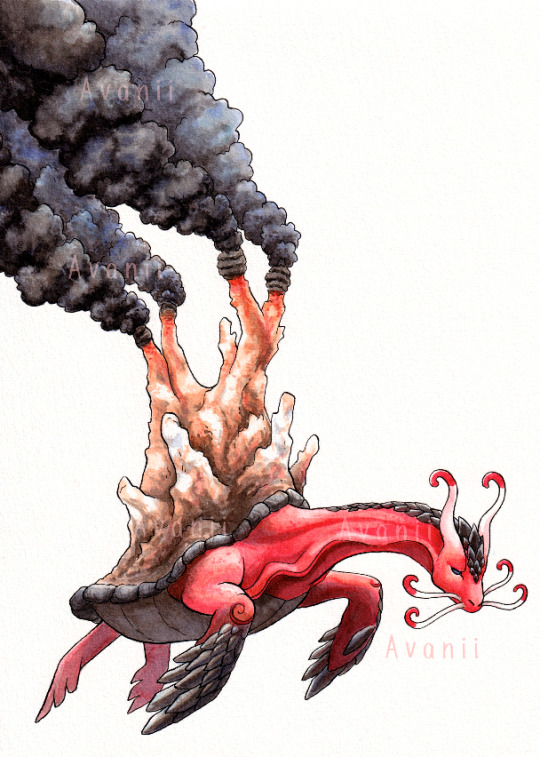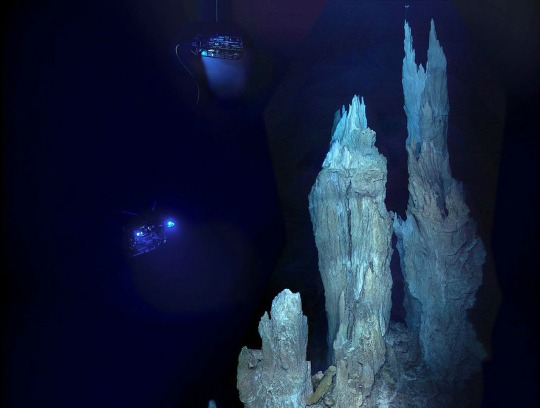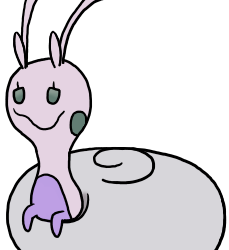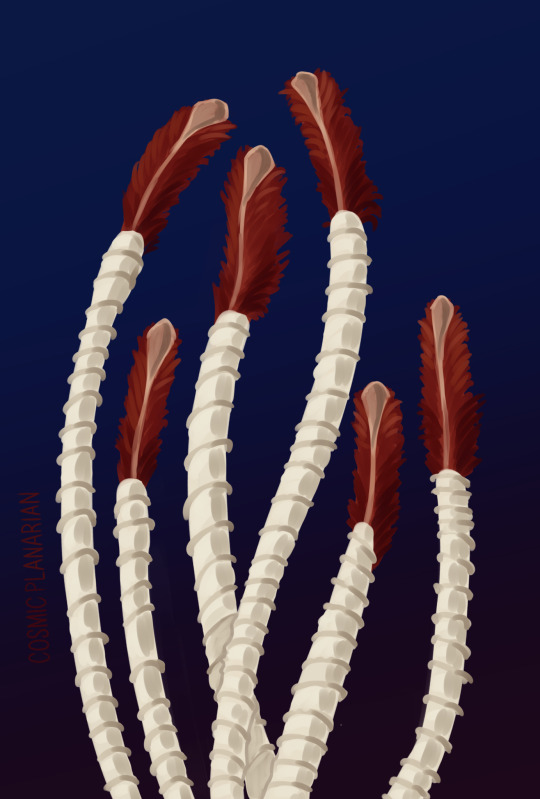#hydrothermal deep sea vent
Text
🪨🐟🪨 🪸🦈🪨🦀🦀⛰️🦀🦀🦀⛰️🦀🦀🦀⛰️🦀🦀🐙🐙
have a mid-atlantic ridge for your dash :)
#the mountains are meant to be hydrothermal vents :)#the coral is a deep sea one#the crabs are yeti crabs#etc#eddie in the ocean#marine biology
165 notes
·
View notes
Text

The Black Smoker Beast can be found roaming the spreading ridges in the depths of the oceans. Hydrothermal vents support a lot of life, so I wanted this creature to look a bit more friendly than my other geology monsters! The enormous, chimney-like structures are absolutely awe-inspiring and I hope I did them justice. I really wanted the beast to have such a chimney for a shell, and gave it the iron armour and red skin of the volcano snail, and white/red whiskers based on the tube worms that make their home at black smokers. Lots of fun again painting with acrylic inks.
#geology monster#volcano monster#black smoker#hydrothermal vent#deep sea creature#I'm really proud of this one#It went through a few different designs for the concept before I landed on this one#if you have never seen videos or photos of hydrothermal vents I beg you to look them up right now#the sheer size and scale of these things is just amazing#they look like underwater cathedrals in some cases#and I love how there's so much life on them too#avanii's art#traditional art
18 notes
·
View notes
Text

had to design a classical CD cover for art class. i turned it into an opportunity to expeirment with making art using the lasso selection tool, i like the lava a lot!
#digital art#firealpaca#deep sea#marine biology#greenland sharks#hydrothermal vents#volcano#artists on tumblr
176 notes
·
View notes
Text

Hydrothermal Vents
134 notes
·
View notes
Text

Charnia
In the distant past of our planet, deep beneath the waves of the ocean, a strange creature has made a living in the pitch black of the deep sea.
Harvesting the energy of a hydrothermal vent, a colony of Charnia glows ghostly in the floodlight of the submarine. What exactly are they? Animal, plant, something entirely different? Finally, this question will be answered…
#art#mine#digital#paleoart#ediacaran#charnia#deep sea#ocean#hydrothermal vents#black smoker#barren#empty#thalassophobia
30 notes
·
View notes
Text


Chrysomallon squamiferum, the Scaly-foot Gastropod (more commonly known as the Volcano Snail) is a species of deep sea snail that have only been found to live in three hydrothermal vent fields, being the Kairei, Solitaire, and Longqi vent fields, all of which are found off the coast of Madagascar. The vent fields they live in can be as hot as 400 degrees celsius (the water does not boil due to the intense pressure)
They're named for the dermal plating along their foot, which is an adaption made to protect against predatory snails, what makes them really unique however is their distinctive ability to incorporate minerals into their shell giving an additional layer of protection. Specimens from the Kairei vent field (shown above) have an iron shell and are even magnetic, due to the higher concentration of greigite (iron sulfide compound), whereas members from the Longqi vent field have goldish shells due to the presence of pyrite and greigite.
They have a mutualistic relationship with a yet unnamed chemosynthetic bacteria that provides energy to the snail. They mainly serve as prey to predatory snail species.
They are unfortunately an endangered species, threatened by deep sea mining, and there are no current plans for conservation.
52 notes
·
View notes
Text


Doodledex - #705-A Hisuian Sliggoo
While there's no outward change to the Goomy that lived in Hisui, the same can't be said for their evolution! Thanks to exposure to high concentrations of iron in the water there, Hisuian Sliggoo are Steel/Dragon types and have developed a large, round, metallic shell! (And yeah, this technically makes them snails instead of slugs.)
However, unlike normal snails that only keep their organs in their shell, Hisuian Sliggoo holes its entire body up in there, with only its head and arms sticking out! It seems like this would make it awkward to move around... but when it needs to go fast it will retract all the way into its shell, stand itself up on its side and roll away!
#pokemon#doodledex#sliggoo#hisuian sliggoo#while iron kinda exists in the bodies of most organisms#(vertebrates especially: it's what makes our blood red!)#an iron shell isn't actually all that strange!#the scaly-foot gastropod is a kind of deep sea snail that really does have iron in its shell!#(and as its name implies in the scales on its foot as well!)#these guys live around hydrothermal vents... which also happens to be where they get their iron!#well more specifically they wind up releasing iron sulfides released by the special bacteria in their bodies that help them process the uh.#vent soup? as the scales and the outer layer of their shell. because apparently snails usually can't handle sulfur all that well#but thanks to this the snail doesn't die of sulfur poisoning AND gets armor out of it!#(one of these iron sulfites is pyrite! there are snails with fool's gold in their bodies and that's pretty darn neat!)
14 notes
·
View notes
Text
bitches will see the incredible ways in which life finds a way and adapts to even the most hostile environments and go "ew thats ugly"
#shortext#YOU COULD NEVERRRRRRRR#yuore nothing compared to the bacteria living in deep sea hydrothermal vents
10 notes
·
View notes
Text
(Please no vanilla extract or micro plastics this time—pollution is no laughing matter)
#poll#marine life#marine biology#deep sea#hydrothermal vent#extremophiles#fish#cephalopods#worms#molluscs#crabs#bacteria
50 notes
·
View notes
Text

100 Days of Sea Creatures Day 58 - Giant Tube Worm (Riftia pachyptila)
#artists on tumblr#artists on instagram#drawing challenge#sea creature art#drawing daily#deep sea creatures#sea creatures#tube worms#hydrothermal vents#deep sea
10 notes
·
View notes
Text






These are deep-sea hydrothermal vent crabs from the Pacific. These preserved specimens were collected by our buddy Nic on a deep-sea expedition.
He aptly named them “Hoff crabs” because they have hairy chests that they use to farm chemosynthetic bacteria which they then eat. The bacteria use the chemicals in the hydrothermal vent to grow.
They were preserved in 95% ethanol at -20C for optimal DNA preservation
#crabs#squat lobster#hoff crab#deep sea science#marine science#hydrothermal vents#deep sea vent#Science side of tumblr#research#marine research
33 notes
·
View notes
Note
do you have any cool ocean words that could work as a name? deep sea related especially
funny enough I'm blanking really hard on that x) I think you'd be better off looking at deep sea organisms' scientific species name and coming up wth a derivative name, or seeing if other languages have names that relate to the sea/the abyss (abyss ones are not common i gotta say, ive looked)
#deep sea words are all like. hydrothermal vents. whalefalls. chemosynthesis. silt. etc etc#ask#anon
8 notes
·
View notes
Text


I made an inflatable sculpture of a hydrothermal vent, complete with tube worms and a starfish!
#had to use mismatched fabric#i disassembled it that very evening after its critique so i could harvest those fabric bits back#deep sea#ocean#hydrothermal vents#ecosystem#i dropped the box fan once during testing and half-cracked-off a fanblade#but it was fine because i unscrewed the fan cage and taped/hotglued it back on#art school#sculpture#artists on tumblr
22 notes
·
View notes
Text

Tube worms
(found in hydrothermal vent environments)
#tube worms#hydrothermal vents#marine science#marine biology#marine invertebrates#deep sea exploration
16 notes
·
View notes
Photo

#tea#tea bag#making tea#dart#sera sophia#hydrothermal vent#deep sea#sometimes I really wish I were drawing on bristol board so I could in solid areas with a brush.. alas the printer paper is the affordable
16 notes
·
View notes
Text

Hydrothermal vent teeming with life.
Source: amnh.org
#archive#archiving#web archive#ocean#sea#deep ocean#deep sea#hydrothermal vent#fish#sea life#aquatic#aquatic creatures#aquatic life
5 notes
·
View notes